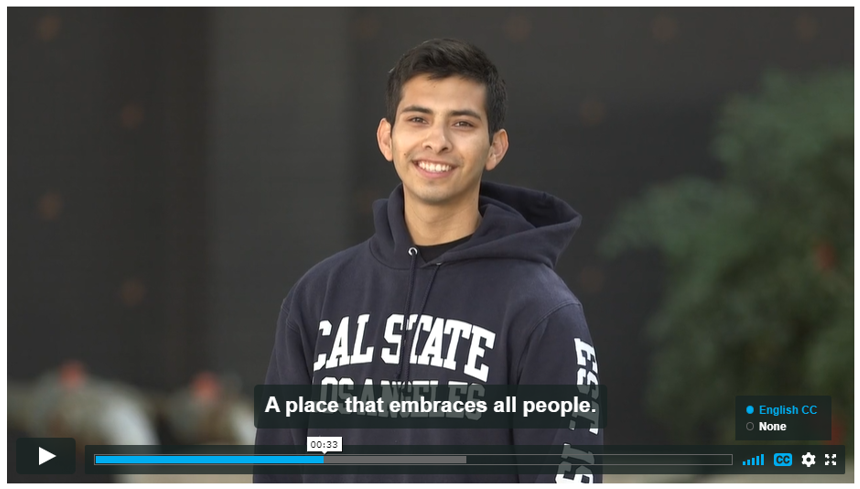Captions
Many students utilize captions for various reasons; captions are recommended for all instructional videos. Captions serve as a means of equal access to auditory content for students who are Deaf or Hard-of-Hearing. Also, captions provide students who are English language learners or those learners that require multiple modalities to retain information an enhanced ability to learn better and retain information.
Captioning Prioritization Guidance
The Chancellor's Office provides guidance on digital content accessibility, including text, audio, still images, animation, or video, regardless of the delivery system.
High Priority:
- An accommodation is requested from a student, staff member, or other person who requires captioning.
- Multimedia will be shared multiple times and over an extended period.
- Multimedia is reused in new courses and newly revised segments of existing courses.
- Multimedia is used in a course for more than one semester.
- If captioning is required for one semester, the quality must be clear enough to allow equivalent access (the ability to infer the meaning of whole sentences). Note: At this time, automatic speech recognition (e.g., YouTube automatic captioning) is unacceptable due to the tendency for errors unless the content owner manually fixes auto-captions.
- Multimedia is on a public-facing web page (e.g., commencements or other public-facing streamed or recorded events, news, and marketing videos).
Other prioritization considerations:
- Any multimedia that is purchased should be delivered in a captioned state. If not, the campus must ensure that captioning will be done upon receipt.
- Archived materials are to be captioned upon request. Caption frequently requested materials.
- Captioning should be outsourced if the campus cannot provide the resources or support specific technical concerns. This requires funding, so each campus budget must accommodate it.
- Commencements or other public-facing events, streamed or recorded, news and marketing videos may require outside services.
- Captioning is a low priority if lecture capture is used to post a lecture that reviews a face-to-face class and will only be available for one semester, and there is no accommodation request.
Selecting Captioned Media
When choosing videos for your course, the easiest method is to select a video that is already manually captioned.
- It is important to note that machine-generated (auto-gen) captions are insufficient to constitute equal access for Deaf or Hard-of-Hearing individuals.
The university subscribes to various video catalogs available through the John F. Kennedy Memorial Library.
YouTube Captions
To check whether YouTube captions are machine-generated, click the "CC" button in the video's lower right-hand corner.
- If there is no CC button, there aren't any captions available.
- If the captions are auto-generated, when you click on the CC button, the top left of the video will show "caption language and (auto-generated), click for settings."
- If the video has manual captions, there will be no mention of "auto-generated," only the language and the "click for settings" prompt will appear.
If you own video assets on YouTube, you can manually correct auto-generated captions through the YouTube studio platform.
Audio Transcripts
Utilize transcripts for audio-only content such as podcasts or interviews. Transcripts provide a written account of auditory content and are also used by those searching audio content by keywords or concepts. We recommended transcripts for audio-only instructional content; faculty and staff can request audio transcripts by completing the Video Caption Request form below and uploading an audio file.
Audio Descriptions
Utilize audio descriptions to create an accessible alternative to visual information displayed without audio narration. Some video styles present informational graphics within the video that are not spoken aloud via a narration track. In this situation, closed captions are unsuitable because no spoken narration is available. The only audio available in these videos tends to be music and leaves a non-sighted individual without the appropriate contextual information. An audio description track can solve this problem by providing a descriptive narrative of the video's visual information; email Accessibility for assistance with audio transcription.
If you are responsible for creating a large volume of media for your department and require your own CaptionSync account, you can request a CaptionSync account online.


